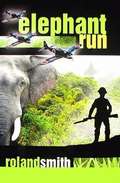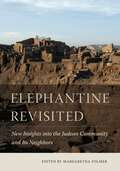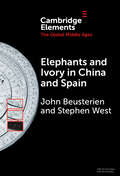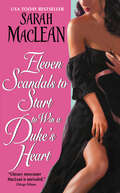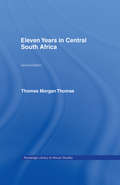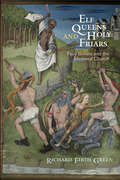- Table View
- List View
Elephant Complex: Travels in Sri Lanka
by John GimletteNo one sees the world quite like John Gimlette. As The New York Times once noted, “he writes with enormous wit, indignation, and a heightened sense of the absurd.” Writing for both the adventurer and the armchair traveler, he has an eye for unusually telling detail, a sense of wonder, and compelling curiosity for the inside story. This time, he travels to Sri Lanka, a country only now emerging from twenty-six years of civil war. Delving deep into the nation’s story, Gimlette provides us with an astonishing, multifaceted portrait of the island today. His travels reveal the country as never before. Beginning in the exuberant capital, Colombo (“a hint of anarchy everywhere”), he ventures out in all directions: to the dry zones where the island’s 5,800 wild elephants congregate around ancient reservoirs; through cinnamon country with its Portuguese forts; to the “Bible Belt” of Buddhism—the tsunami-ravaged southeast coast; then up into the great green highlands (“the garden in the sky”) and Kandy, the country’s eccentric, aristocratic Shangri-la. Along the way, a wild and often desperate history takes shape, a tale of great colonies (Arab, Portuguese, British, and Dutch) and of the cultural divisions that still divide this society. Before long, we’re in Jaffna and the Vanni, crucibles of the recent conflict. These areas—the hottest, driest, and least hospitable—have been utterly devastated by war and are only now struggling to their feet.But this is also a story of friendship and remarkable encounters. In the course of his journey, Gimlette meets farmers, war heroes, ancient tribesmen, world-class cricketers, terrorists, a former president, old planters, survivors of great massacres—and perhaps some of their perpetrators. That’s to say nothing of the island’s beguiling fauna: elephants, crocodiles, snakes, storks, and the greatest concentration of leopards on Earth. Here is a land of extravagant beauty and profound devastation, of ingenuity and catastrophe, possessed of both a volatile past and an uncertain future—a place capable of being at once heavenly and hellish—all brought to vibrant, fascinating life here on the page.From the Hardcover edition.
Elephant Run
by Roland SmithIn 1941, bombs drop from the night skies of London, demolishing the apartment Nick Freestone lives in with his mother. Deciding the situation in England is too unstable, Nick's mother sends him to live with his father in Burma, hoping he will be safer living on the family's teak plantation. But as soon as Nick arrives, trouble erupts in the remote Burmese elephant village. Japanese soldiers invade, and Nick's father is taken prisoner. Nick is left stranded on the plantation, forced to work as a servant to the new rulers. As life in the village grows more dangerous for Nick and his young friend, Mya, they plan their daring escape. Setting off on elephant back, they will risk their lives to save Nick's father and Mya's brother from a Japanese POW camp.
Elephant Slaves & Pampered Parrots: Exotic Animals in Eighteenth-Century Paris (Animals, History, Culture)
by Louise E. RobbinsThis lively history “adds a new dimension to our understanding of 18th-century France” by exploring the Parisian fashion of importing exotic animals (American Historical Review).In 1775, a visitor to Laurent Spinacuta’s Grande Ménagerie at the annual winter fair in Paris would have seen two tigers, several kinds of monkeys, an armadillo, an ocelot, and a condor—in all, forty-two live animals. In the streets of the city, one could observe performing elephants and a fighting polar bear. Those looking for unusual pets could purchase parrots, flying squirrels, and capuchin monkeys. The royal menagerie at Versailles displayed lions, cranes, an elephant, a rhinoceros, and a zebra, which in 1760 became a major court attraction.For Enlightenment-era Parisians, exotic animals piqued scientific curiosity and conveyed social status. Their variety and accessibility were a boon for naturalists like Buffon, author of Histoire naturelle. Louis XVI use his menagerie to demonstrate his power, while critics saw his caged animals as metaphors of slavery and oppression. In her engaging account, Robbins considers nearly every aspect of France’s obsession with exotic fauna, from the animals’ transportation and care to the inner workings of the oiseleurs’ (birdsellers’) guild. Based on wide-ranging research, Elephant Slaves and Pampered Parrots offers a major contribution to the history of human-animal relations, eighteenth-century culture, and French colonialism.
Elephant Slaves and Pampered Parrots: Exotic Animals in Eighteenth-Century Paris (Animals, History, Culture)
by Louise E. RobbinsIn 1775, a visitor to Laurent Spinacuta's Grande Ménagerie at the annual winter fair in Paris would have seen two tigers, several kinds of monkeys, an armadillo, an ocelot, and a condor—in all, forty-two live animals. In Elephant Slaves and Pampered Parrots, Louise Robbins explains that exotic animals from around the world were common in eighteenth-century Paris. In the streets of the city, residents and visitors could observe performing elephants and a fighting polar bear. Those looking for unusual pets could purchase parrots, flying squirrels, and capuchin monkeys. The royal menagerie at Versailles displayed lions, cranes, an elephant, a rhinoceros, and a zebra, which in 1760 became a major court attraction.For Enlightenment-era Parisians, exotic animals both piqued scientific curiosity and conveyed social status. Their availability was a boon for naturalists like Buffon, author of the best-selling Histoire naturelle, who observed unusual species in a variety of locations around the city. Louis XVI saw his menagerie as a manifestation of his power and funded its upkeep accordingly, while critics used the caged animals as metaphors of slavery and political oppression amidst the growing political turmoil. In her engaging and often surprising account, Robbins considers nearly every aspect of France's obsession with exotic fauna, from the vast literature on exotic animals and the inner workings of the oiseleurs' (birdsellers') guild to how the animals were transported, housed, and cared for. Based on wide-ranging and imaginative research, Elephant Slaves and Pampered Parrots stands as a major contribution to the history of human-animal relations, eighteenth-century culture, and French colonialism.
Elephant Trails: A History of Animals and Cultures (Animals, History, Culture)
by Nigel RothfelsWhy have elephants—and our preconceptions about them—been central to so much of human thought?From prehistoric cave drawings in Europe and ancient rock art in Africa and India to burning pyres of confiscated tusks, our thoughts about elephants tell a story of human history. In Elephant Trails, Nigel Rothfels argues that, over millennia, we have made elephants into both monsters and miracles as ways to understand them but also as ways to understand ourselves.Drawing on a broad range of sources, including municipal documents, zoo records, museum collections, and encounters with people who have lived with elephants, Rothfels seeks out the origins of our contemporary ideas about an animal that has been central to so much of human thought. He explains how notions that have been associated with elephants for centuries—that they are exceptionally wise, deeply emotional, and have a special understanding of death; that they never forget, are beloved of the gods, and suffer unusually in captivity; and even that they are afraid of mice—all tell part of the story of these amazing beings. Exploring the history of a skull in a museum, a photograph of an elephant walking through the American South in the early twentieth century, the debate about the quality of life of a famous elephant in a zoo, and the accounts of elephant hunters, Rothfels demonstrates that elephants are not what we think they are—and they never have been. Elephant Trails is a compelling portrait of what the author terms "our elephant."
Elephantine Revisited: New Insights into the Judean Community and Its Neighbors
by Margaretha FolmerThe Judean community at Elephantine has long fascinated historians of the Persian period. This book, with its stellar assemblage of important scholarly voices, provides substantive new insights and approaches that will advance the study of this well-known but not entirely understood community from fifth-century BCE Egypt. Since Bezalel Porten’s pioneering Archives from Elephantine, published in 1968, the discourse on the subject of the community of Elephantine during the Persian period has changed considerably, due to new data from excavations, the discovery and publication of previously unknown texts, and original scholarly insights and avenues of inquiry. Running the gamut from archaeological to linguistic investigations and encompassing legal, literary, religious, and other aspects of life in this Judean community, this volume stands at a crossroads of research that extends from Hebrew Bible studies to the history of early Jewish communities. It also features fourteen new Aramaic ostraca from Aswan. The volume will appeal to students and scholars of the Hebrew Bible and ancient Judaism, as well as to a wider audience of Egyptologists, Semitists, and specialists in ancient Near Eastern studies. In addition to the editor, the contributors to this volume include Annalisa Azzoni, Bob Becking, Alejandro F. Botta, Lester L. Grabbe, Ingo Kottsieper, Reinhard G. Kratz, André Lemaire, Hélène Nutkowicz, Beatrice von Pilgrim, Cornelius von Pilgrim, Bezalel Porten, Ada Yardeni, and Ran Zadok. Moreover, a video recording of an interview conducted with Porten on his long career in Elephantine studies accompanies the book through a link on the Eisenbrauns website.
Elephantine Revisited: New Insights into the Judean Community and Its Neighbors
by Margaretha FolmerThe Judean community at Elephantine has long fascinated historians of the Persian period. This book, with its stellar assemblage of important scholarly voices, provides substantive new insights and approaches that will advance the study of this well-known but not entirely understood community from fifth-century BCE Egypt. Since Bezalel Porten’s pioneering Archives from Elephantine, published in 1968, the discourse on the subject of the community of Elephantine during the Persian period has changed considerably, due to new data from excavations, the discovery and publication of previously unknown texts, and original scholarly insights and avenues of inquiry. Running the gamut from archaeological to linguistic investigations and encompassing legal, literary, religious, and other aspects of life in this Judean community, this volume stands at a crossroads of research that extends from Hebrew Bible studies to the history of early Jewish communities. It also features fourteen new Aramaic ostraca from Aswan. The volume will appeal to students and scholars of the Hebrew Bible and ancient Judaism, as well as to a wider audience of Egyptologists, Semitists, and specialists in ancient Near Eastern studies. In addition to the editor, the contributors to this volume include Annalisa Azzoni, Bob Becking, Alejandro F. Botta, Lester L. Grabbe, Ingo Kottsieper, Reinhard G. Kratz, André Lemaire, Hélène Nutkowicz, Beatrice von Pilgrim, Cornelius von Pilgrim, Bezalel Porten, Ada Yardeni, and Ran Zadok. Moreover, a video recording of an interview conducted with Porten on his long career in Elephantine studies accompanies the book through a link on the Eisenbrauns website.
Elephants & Kings: An Environmental History
by Thomas R. TrautmannBecause of their enormous size, elephants have long been irresistible for kings as symbols of their eminence. In early civilizations—such as Egypt, Mesopotamia, the Indus Civilization, and China—kings used elephants for royal sacrifice, spectacular hunts, public display of live captives, or the conspicuous consumption of ivory—all of them tending toward the elephant’s extinction. The kings of India, however, as Thomas R. Trautmann shows in this study, found a use for elephants that actually helped preserve their habitat and numbers in the wild: war. Trautmann traces the history of the war elephant in India and the spread of the institution to the west—where elephants took part in some of the greatest wars of antiquity—and Southeast Asia (but not China, significantly), a history that spans 3,000 years and a considerable part of the globe, from Spain to Java. He shows that because elephants eat such massive quantities of food, it was uneconomic to raise them from birth. Rather, in a unique form of domestication, Indian kings captured wild adults and trained them, one by one, through millennia. Kings were thus compelled to protect wild elephants from hunters and elephant forests from being cut down. By taking a wide-angle view of human-elephant relations, Trautmann throws into relief the structure of India’s environmental history and the reasons for the persistence of wild elephants in its forests.
Elephants Can Remember: A Hercule Poirot Mystery: The Official Authorized Edition (Hercule Poirot Mysteries #36)
by Agatha ChristieA classic Hercule Poirot investigation, Agatha Christie’s Elephants Can Remember has the expert detective delving into an unsolved crime from the past involving the strange death of a husband and wife.Hercule Poirot stood on the clifftop. Here, many years earlier, there had been a fatal accident followed by the grisly discovery of two bodies—a husband and wife who had been shot dead.But who had killed whom? Was it a suicide pact? A crime of passion? Or cold-blooded murder? Poirot delves into the past and discovers that “old sins leave long shadows.”
Elephants and Ivory in China and Spain (Elements in the Global Middle Ages)
by John Beusterien Stephen WestThe Element provides a global history of ivory and elephants, acknowledging the individuality and dignity of the elephants that provided that ivory. Sections on China include the first translations of texts about the cultural importance of elephants and ivory in the Song Dynasty (960–1279) and an examination of an ivory stave (huban 笏板), crafted from an Asian elephant tusk (Elephas maximus), carried by officials in court and other formal rituals. Sections on Spain examine the value of ivory during the reign of King Alfonso X of Castille (1221–1284) and the Virxe Abrideira (ca. 1260–1275), an ivory Virgin and Child statuette owned by Queen Violante of Aragon (1236–1301), crafted from an African elephant tusk (Loxodonta africana). The Element concludes by offering a pedagogy from a comparative literature perspective about Sunjata (c.1226), an epic from the Mali empire in West Africa, an important source for thirteenth-century global ivory markets.
Elephants and Kings: An Environmental History
by Thomas R. TrautmannBecause of their enormous size, elephants have long been irresistible for kings as symbols of their eminence. In early civilizations--such as Egypt, Mesopotamia, the Indus Civilization, and China--kings used elephants for royal sacrifice, spectacular hunts, public display of live captives, or the conspicuous consumption of ivory--all of them tending toward the elephant's extinction. The kings of India, however, as Thomas R. Trautmann shows in this study, found a use for elephants that actually helped preserve their habitat and numbers in the wild: war. Trautmann traces the history of the war elephant in India and the spread of the institution to the west--where elephants took part in some of the greatest wars of antiquity--and Southeast Asia (but not China, significantly), a history that spans 3,000 years and a considerable part of the globe, from Spain to Java. He shows that because elephants eat such massive quantities of food, it was uneconomic to raise them from birth. Rather, in a unique form of domestication, Indian kings captured wild adults and trained them, one by one, through millennia. Kings were thus compelled to protect wild elephants from hunters and elephant forests from being cut down. By taking a wide-angle view of human-elephant relations, Trautmann throws into relief the structure of India's environmental history and the reasons for the persistence of wild elephants in its forests.
Elevate the Masses: Alexander Gardner, Photography, and Democracy in Nineteenth-Century America
by Makeda BestAlexander Gardner is best known for his innovative photographic history of the Civil War. What is less known is the extent to which he was involved in the international workers’ rights movement. Tying Gardner’s photographic storytelling to his transatlantic reform activities, this book expands our understanding of Gardner’s career and the work of his studio in Washington, DC, by situating his photographic production within the era’s discourse on social and political reform.Drawing on previously unknown primary sources and original close readings, Makeda Best reveals how Gardner’s activism in Scotland and photography in the United States shared an ideological foundation. She reads his Photographic Sketch Book of the War as a politically motivated project, rooted in Gardner’s Chartist and Owenite beliefs, and illuminates how its treatment of slavery is primarily concerned with the harm that the institution posed to the United States’ reputation as a model democracy. Best shows how, in his portraiture, Gardner celebrated Northern labor communities and elevated white immigrant workers, despite the industrialization that degraded them. She concludes with a discussion of Gardner’s promotion of an American national infrastructure in which photographers and photography played an integral role.Original and compelling, this reconsideration of Gardner’s work expands the contribution of Civil War photography beyond the immediate narrative of the war to comprehend its relation to the vigorous international debates about democracy, industrialization, and the rights of citizens. Scholars working at the intersection of photography, cultural history, and social reform in the nineteenth century on both sides of the Atlantic will find Best’s work invaluable to their own research.
Elevate the Masses: Alexander Gardner, Photography, and Democracy in Nineteenth-Century America
by Makeda BestAlexander Gardner is best known for his innovative photographic history of the Civil War. What is less known is the extent to which he was involved in the international workers’ rights movement. Tying Gardner’s photographic storytelling to his transatlantic reform activities, this book expands our understanding of Gardner’s career and the work of his studio in Washington, DC, by situating his photographic production within the era’s discourse on social and political reform.Drawing on previously unknown primary sources and original close readings, Makeda Best reveals how Gardner’s activism in Scotland and photography in the United States shared an ideological foundation. She reads his Photographic Sketch Book of the War as a politically motivated project, rooted in Gardner’s Chartist and Owenite beliefs, and illuminates how its treatment of slavery is primarily concerned with the harm that the institution posed to the United States’ reputation as a model democracy. Best shows how, in his portraiture, Gardner celebrated Northern labor communities and elevated white immigrant workers, despite the industrialization that degraded them. She concludes with a discussion of Gardner’s promotion of an American national infrastructure in which photographers and photography played an integral role.Original and compelling, this reconsideration of Gardner’s work expands the contribution of Civil War photography beyond the immediate narrative of the war to comprehend its relation to the vigorous international debates about democracy, industrialization, and the rights of citizens. Scholars working at the intersection of photography, cultural history, and social reform in the nineteenth century on both sides of the Atlantic will find Best’s work invaluable to their own research.
Elevating the Game: The History and Aesthetics of Black Men in Basketball
by Nelson GeorgeThe author of "The Michael Jackson Story" argues that black basketball players have reinvented the game. By researching the history of basketball George exposes African American icons who have revolutionized dribbling. He tells the stories of those black individuals who advanced the sport's technique, and who influenced its strategy. The author skillfully narrates the African American history that is integral to the history of basketball.
Eleven Days in August: The Liberation of Paris in 1944
by Matthew Cobb'I had thought that for me there could never again be any elation in war. But I had reckoned without the liberation of Paris - I had reckoned without remembering that I might be a part of that richly historic day. We were in Paris on the first day - one of the great days of all time.' (Ernie Pyle, US war correspondent)The liberation of Paris was a momentous point in twentieth-century history, yet it is now largely forgotten outside France. Eleven Days in August is a pulsating hour-by-hour reconstruction of these tumultuous events that shaped the final phase of the war and the future of France, told with the pace of a thriller. While examining the conflicting national and international interests that played out in the bloody street fighting, it tells of how, in eleven dramatic days, people lived, fought and died in the most beautiful city in the world. Based largely on unpublished archive material, including secret conversations, coded messages, diaries and eyewitness accounts, Eleven Days in August shows how these August days were experienced in very different ways by ordinary Parisians, Resistance fighters, French collaborators, rank-and-file German soldiers, Allied and French spies, the Allied and German High Commands.Above all, it shows that while the liberation of Paris may be attributed to the audacity of the Resistance, the weakness of the Germans and the strength of the Allies, the key to it all was the Parisians who by turn built street barricades and sunbathed on the banks of the Seine, who fought the Germans and simply tried to survive until the Germans finally surrendered, in a billiard room at the Prefecture of Police. One of the most iconic moments in the history of the twentieth century had come to a close, and the face of Paris would never be the same again.
Eleven Exiles: Accounts of Loyalists of the American Revolution
by John Grant Phyllis R. BlakeleyEleven Exiles is a personal account of the American Revolution. By focusing on eleven different people who were on the losing side of the American Revolution, and who had to make new lives for themselves in what remained of British North America. Eleven Exiles reflects the major themes of those turbulent years. What were the attitudes of these men and women toward the significant social and political ideas of the time? What motivated them to leave their home and move to a wildnerness? What challenges and hardships did they face?
Eleven Scandals to Start to Win a Duke's Heart (Love By Numbers #3)
by Sarah MacLeanShe lives for passion.Bold, impulsive, and a magnet for trouble, Juliana Fiori is no simpering English miss. She refuses to play by society's rules: she speaks her mind, cares nothing for the approval of the ton, and can throw a punch with remarkable accuracy. Her scandalous nature makes her a favorite subject of London's most practiced gossips . . . and precisely the kind of woman The Duke of Leighton wants far far away from him.He swears by reputation.Scandal is the last thing Simon Pearson has room for in his well-ordered world. The Duke of Disdain is too focused on keeping his title untainted and his secrets unknown. But when he discovers Juliana hiding in his carriage late one evening--risking everything he holds dear--he swears to teach the reckless beauty a lesson in propriety. She has other plans, however; she wants two weeks to prove that even an unflappable duke is not above passion.
Eleven Scandals to Start to Win a Duke's Heart: Number 3 in series (Love by Numbers #3)
by Sarah MacLean'Fabulous' Eloisa James'Smart, sexy, and always romantic' Julia Quinn'For a smart, witty and passionate historical romance, I recommend anything by Sarah MacLean' Lisa KleypasShe lives for passion. Bold, impulsive, and a magnet for trouble, Juliana Fiori is no simpering English miss. She refuses to play by society's rules: she speaks her mind, cares nothing for the approval of the ton, and can throw a punch with remarkable accuracy. Her scandalous nature makes her a favorite subject of London's most practiced gossips . . . and precisely the kind of woman the Duke of Leighton wants far far away from him. He swears by reputation. Scandal is the last thing Simon Pearson has room for in his well-ordered world. The Duke of Disdain is too focused on keeping his title untainted and his secrets unknown. But when he discovers Juliana hiding in his carriage late one evening - risking everything he holds dear - he swears to teach the reckless beauty a lesson in propriety. She has other plans, however; she wants two weeks to prove that even an unflappable duke is not above passion.This is the third novel in the Regency romance Love By Numbers trilogy by New York Times bestselling author Sarah MacLean - perfect for fans of Lisa Kleypas and Eloisa JamesLove By Numbers series:Nine Rules to Break When Romancing a RakeTen Ways to Be Adored When Landing a LordEleven Scandals to Start to Win a Duke's HeartPraise for Sarah MacLean:'Sarah MacLean has reignited the romance genre with a bolder edge' The New Yorker'Funny, smart, feminist and roastingly hot' BookRiot.com'Do yourself a favor and discover the compelling magic of Sarah MacLean' Amanda Quick'MacLean writes with an entirely unique blend of elegance and ferocity that bursts from every page' Entertainment Weekly'Great chemistry, intelligence and sparkling humor' RT Book Reviews
Eleven Winters of Discontent: The Siberian Internment and the Making of a New Japan
by Sherzod MuminovThe odyssey of 600,000 imperial Japanese soldiers incarcerated in Soviet labor camps after World War II and their fraught repatriation to postwar Japan. In August 1945 the Soviet Union seized the Japanese puppet state of Manchukuo and the colony of Southern Sakhalin, capturing more than 600,000 Japanese soldiers, who were transported to labor camps across the Soviet Union but primarily concentrated in Siberia and the Far East. Imprisonment came as a surprise to the soldiers, who thought they were being shipped home. The Japanese prisoners became a workforce for the rebuilding Soviets, as well as pawns in the Cold War. Alongside other Axis POWs, they did backbreaking jobs, from mining and logging to agriculture and construction. They were routinely subjected to “reeducation” glorifying the Soviet system and urging them to support the newly legalized Japanese Communist Party and to resist American influence in Japan upon repatriation. About 60,000 Japanese didn’t survive Siberia. The rest were sent home in waves, the last lingering in the camps until 1956. Already laid low by war and years of hard labor, returnees faced the final shock and alienation of an unrecognizable homeland, transformed after the demise of the imperial state. Sherzod Muminov draws on extensive Japanese, Russian, and English archives—including memoirs and survivor interviews—to piece together a portrait of life in Siberia and in Japan afterward. Eleven Winters of Discontent reveals the real people underneath facile tropes of the prisoner of war and expands our understanding of the Cold War front. Superpower confrontation played out in the Siberian camps as surely as it did in Berlin or the Bay of Pigs.
Eleven Years In Soviet Prison Camps
by Elinor LipperThe shocking and absorbing account of life in the hell of the Soviet Gulag system is told in all his horrific details here by Elinor Lipper."IN THIS BOOK I have described my personal experiences only to the extent that they were the characteristic experiences of a prisoner in the Soviet Union. For my concern is not primarily with the foreigners in Soviet camps; it is rather with the fate of all the peoples who have been subjugated by the Soviet regime, who were born in a Soviet Republic and cannot escape from it.The events I describe are the daily experiences of thousands or people in the Soviet Union. They are the findings of an involuntary expedition into an unknown land: the land of Soviet prisoners, of the guiltless damned. From that region I have brought back with me the silence of the Siberian graveyards, the deathly silence of those who have frozen, starved, or been beaten to death. This book is an attempt to make that silence speak."-from the Author's Preface.
Eleven Years in Central South Africa
by Thomas Morgan ThomasAn important surviving source for the study of the spectacular and short-lived kingdom of Ndebele. In the literature of pre-conquest Rhodesia, Thomas' book stands out by virtue of its ethnographical and political material about the Ndebele under Mzilikazi and Lebengula.
Eleventh Hour: A Tudor mystery featuring Christopher Marlowe (The Kit Marlowe Mysteries #8)
by M. J. TrowChristopher Marlowe plays the role of sleuth to discover who killed the queen&’s spymaster in this &“bawdy, witty . . . historically informed&” Elizabethan mystery (Kirkus Reviews). April, 1590. When the queen&’s spymaster, Sir Francis Walsingham, dies of a stroke, the sudden event leaves a dangerous power vacuum in her majesty&’s court. Walsingham&’s former right-hand man, Nicholas Faunt, believes he was poisoned. And he calls upon the poet and playwright Christopher &“Kit&” Marlowe to discover who killed him. To get to the bottom of this perplexing mystery, Kit must consult England&’s leading scientists and thinkers. But as he questions the members of the so-called School of Night, the playwright-turned-spy becomes convinced that at least one of them is hiding a deadly secret. If he is to outwit the most enquiring minds in Europe and unmask the killer within, Kit must devise an impossibly ingenious plan. Good thing he has a knack for formulating plots. &“As always, Trow provides fascinating period authenticity, a crackling plot, strong characters, and plenty of twists.&” —Booklist
Eleventh Month, Eleventh Day, Eleventh Hour: The War to End All Wars and Its Violent End
by Joseph E. PersicoThe story of the day on which World War I, the war to end all wars, ended. Using military archives and public records, along with journals and diaries, the book will weave together the eleventh hour experiences of the famous, such as Lloyd George, President Woodrow Wilson, Field Marshall Haig and General Pershing. But more dominantly, it will deal with the ordinary men in the trenches, unsung and unremembered, the British Tommies, French Poilus, American Doughboys and German Feldgrau. Where, for example, was the Austrian corporal, Adolf Hitler, on that day? Four days before the War's end, with peace talks already underway, the beaten Germans propose an interim ceasefire to spare lives. However, the French Allied Commander, General Ferdinand Foch, refuses. Hostilities will not cease, Foch insists, before the appointed hour of the Armistice. Thus, even on the last day, the Allies are still launching full scale offenses and both sides bombard each other until the final minute of the agreed ceasefire, 11am, November 11, 1918. The last hours pulsate with tension as men in the trenches, airmen in the sky and sailors at sea hope to escape the melancholy distinction of being the last to die in the War.
Elf Queens and Holy Friars: Fairy Beliefs and the Medieval Church (The Middle Ages Series)
by Richard Firth GreenIn Elf Queens and Holy Friars Richard Firth Green investigates an important aspect of medieval culture that has been largely ignored by modern literary scholarship: the omnipresent belief in fairyland.Taking as his starting point the assumption that the major cultural gulf in the Middle Ages was less between the wealthy and the poor than between the learned and the lay, Green explores the church's systematic demonization of fairies and infernalization of fairyland. He argues that when medieval preachers inveighed against the demons that they portrayed as threatening their flocks, they were in reality often waging war against fairy beliefs. The recognition that medieval demonology, and indeed pastoral theology, were packed with coded references to popular lore opens up a whole new avenue for the investigation of medieval vernacular culture.Elf Queens and Holy Friars offers a detailed account of the church's attempts to suppress or redirect belief in such things as fairy lovers, changelings, and alternative versions of the afterlife. That the church took these fairy beliefs so seriously suggests that they were ideologically loaded, and this fact makes a huge difference in the way we read medieval romance, the literary genre that treats them most explicitly. The war on fairy beliefs increased in intensity toward the end of the Middle Ages, becoming finally a significant factor in the witch-hunting of the Renaissance.
Elgin, Illinois: From the Collection of the Elgin Area Historical Society
by Jim Edwards Wynette EdwardsElgin was named by a city founder, James T. Gifford, after his favorite hymn. The city shares its name with 20 cities in 15 states and 8 countries. Elgin is situated on the banks of the Fox River, 35 milesnorthwest of Chicago, the city with which Elgin had thriving business exchanges in agricultural and industrial goods. The city's world-wide fame, for the most part, has come from its watch factory and Mr. Gail Borden's milk company. Pianos, shoes, books, and even chewing gum were also manufactured in Elgin and sold internationally. This exciting new study of a major Midwestern city is chock-full of images, many of which have never before been published. Featured in Elgin, Illinois is information about the Elgin National Watch Company, early circus and carnival attractions, as well as rip-roaring national road races. Highlighted in one chapter is Elgin's part in helping to win World War Iat home, complete with original photographs from the front in Europe. This lively and historical look at Elgin from the 1800s to the 1930s is interwoven with national and international trends and events.

